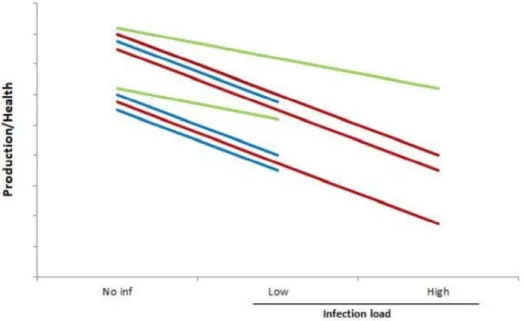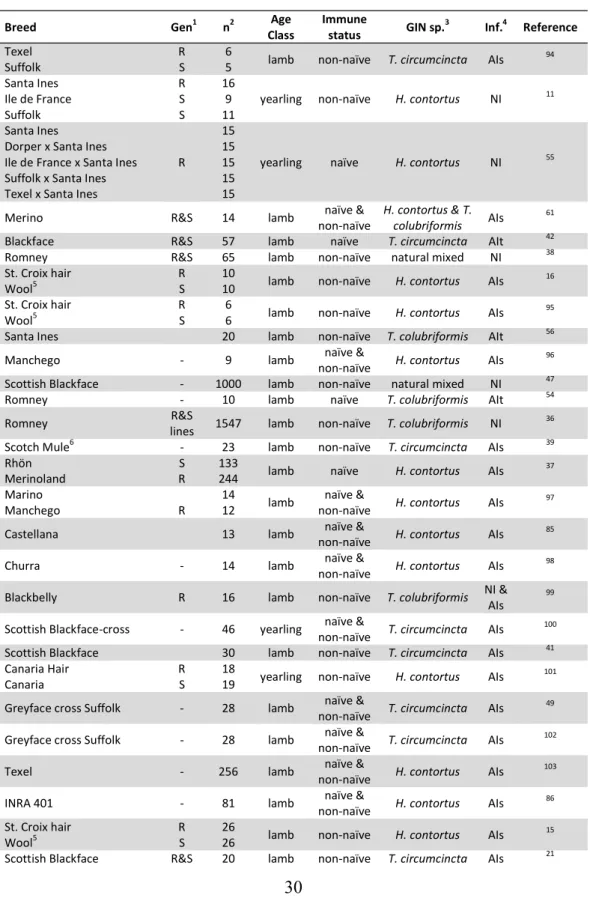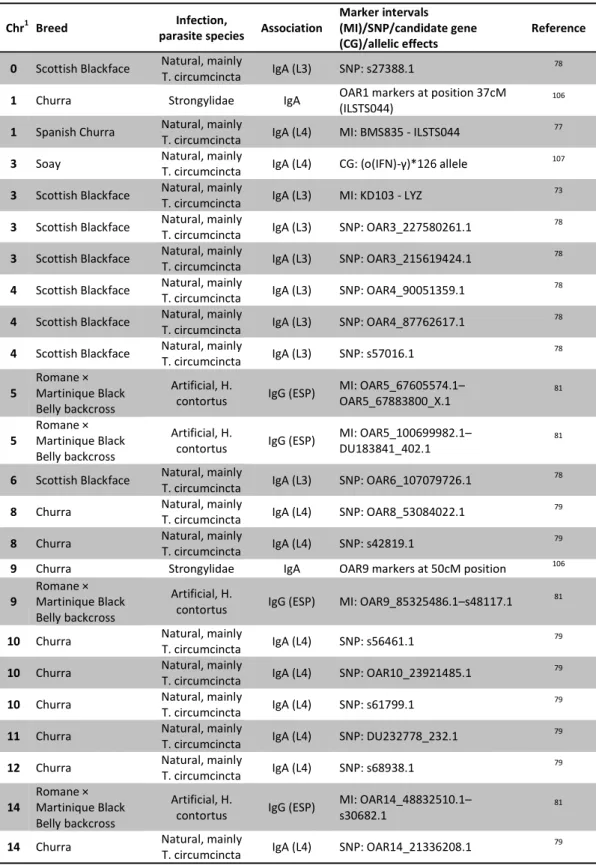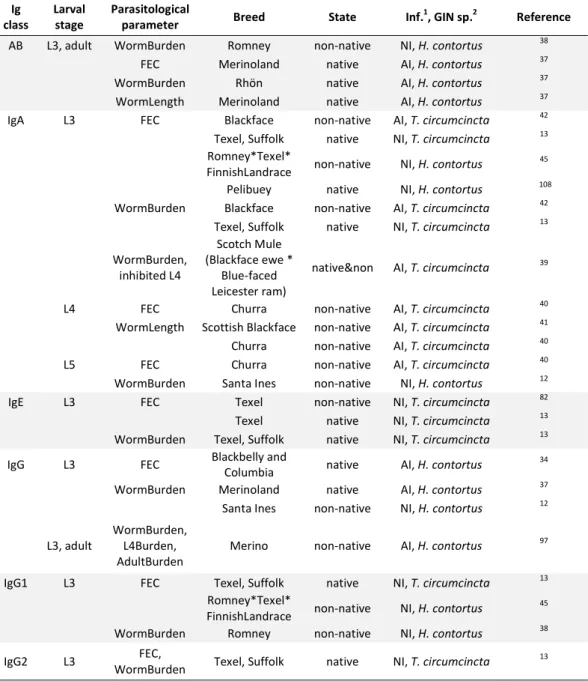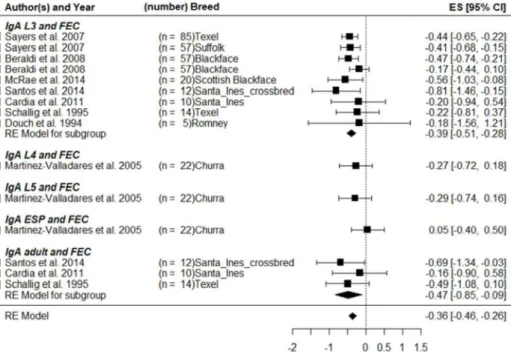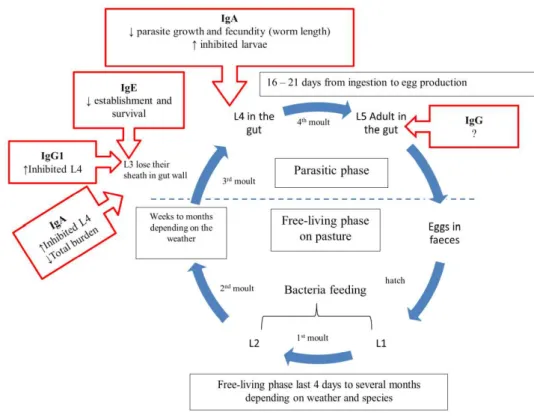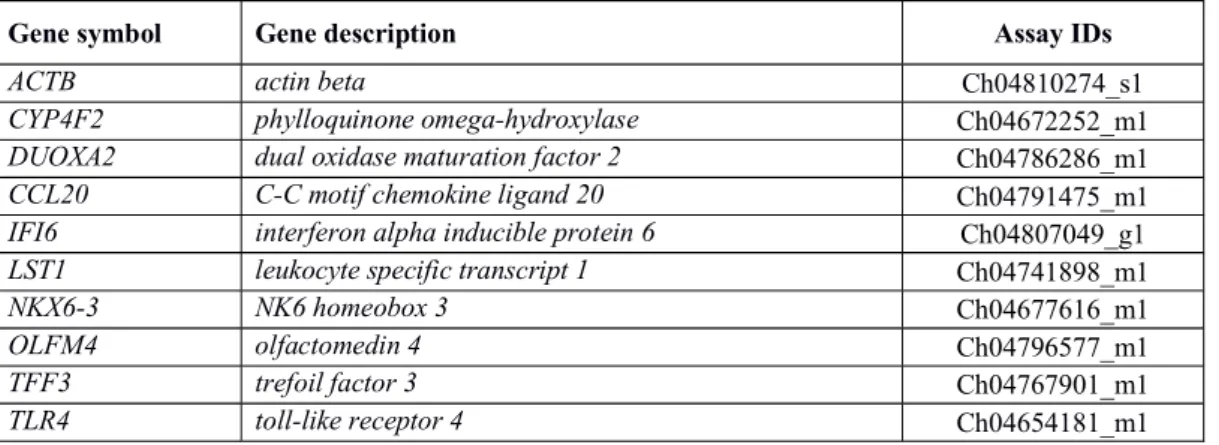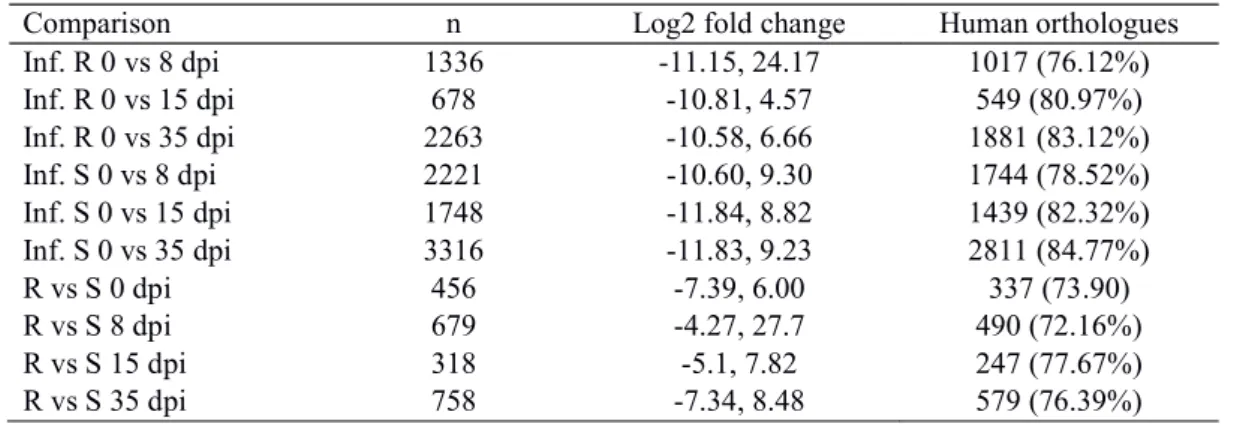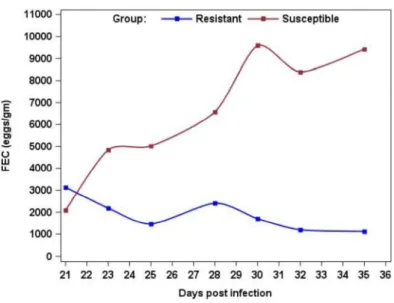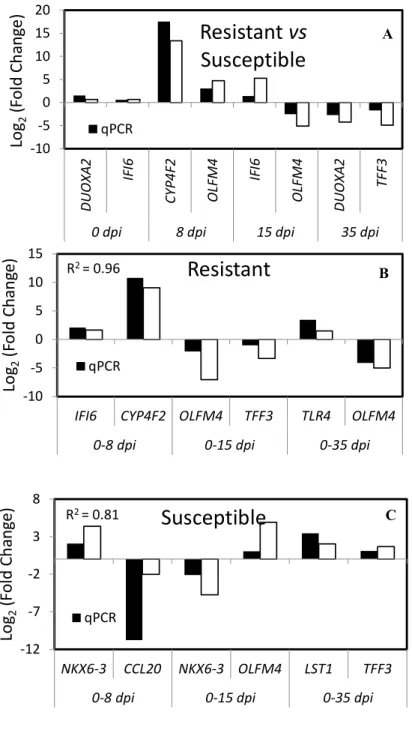HAL Id: tel-02974356
https://hal.inrae.fr/tel-02974356
Submitted on 21 Oct 2020HAL is a multi-disciplinary open access
archive for the deposit and dissemination of sci-entific research documents, whether they are pub-lished or not. The documents may come from teaching and research institutions in France or abroad, or from public or private research centers.
L’archive ouverte pluridisciplinaire HAL, est destinée au dépôt et à la diffusion de documents scientifiques de niveau recherche, publiés ou non, émanant des établissements d’enseignement et de recherche français ou étrangers, des laboratoires publics ou privés.
Genomic variation and molecular mechanisms of the
host response to gastrointestinal nematodes in small
ruminants
Hadeer Aboshady
To cite this version:
Hadeer Aboshady. Genomic variation and molecular mechanisms of the host response to gastrointesti-nal nematodes in small ruminants. Animal genetics. AgroParisTech, 2020. English. �tel-02974356�
Genomic variation and molecular
mechanisms of the host response to
gastrointestinal nematodes in small
ruminants
Hadeer Aboshady
Faculty of Veterinary Medicine and
Animal Science
Department of Animal Breeding and Genetics
Uppsala
and
AgroParisTech
France
Doctoral thesis
Swedish University of
Agricultural Sciences
Uppsala 2020
Acta Universitatis agriculturae Sueciae
2020:XXX
ISSN 1652-6880
ISBN (print version) 978-91-7760-XXX-X
ISBN (electronic version) 978-91-7760-XXX-X
© 2020 Hadeer Mohsen Moursy Aly Aboshady, Uppsala
Print: SLU Service/Repro, Uppsala 2020
Gastrointestinal nematode (GIN) infections are one of the major constrains for sheep and goat production worldwide. One of the promising control strategies is the genetic selection for resistant animals as there are no issues due to anthelmintic resistance and it aligns to demands for chemical-free food. Exploring possible phenotypic and genomic markers that could be used in breeding scheme besides understanding the mechanisms responsible for resistance were the main goals of this thesis.
Thesis consists of General introduction, a brief description of GIN biology and methods to control GIN with focus on phenotypic and genomic markers, four papers and General discussion. In paper , a systematic review and meta-analysis were conducted to re-analyse and summarize the findings on immunoglobulins response to GIN in the literature and discuss the potential to use immunoglobulins as biomarkers of the host resistance. A conceptual model summarizing the role of immunoglobulins in resistance to GIN is proposed. In paper , transcriptome profiling of the abomasal mucosa and lymph node tissues were compared between non-infected, resistant and susceptible Creole goats experimentally infected with Haemonchus contortus. Results indicated that the maintenance of the integrity of the mucosa has probably the priority for the host at late infection stage. In , the dynamics of the response of the abomasal mucosa of resistant and susceptible Creole goats experimentally infected with H. contortus were compared. The immune response was activated through many relevant pathways including the Th1 immune response at different time post-infection. Interestingly, the results showed a simultaneous time series activation of Th2 related genes in resistant compared to susceptible kids. In paper , the genomic variants of Creole goats resistant and susceptible to H. contortus were discovered from RNA-sequencing data at four different times post-infection. Single nucleotide polymorphisms, insertions and deletions that distinguish the resistant and the susceptible groups were identified and characterized through functional analysis. The T cell receptor signalling pathway was one of the top significant pathways that distinguish the resistant from the susceptible group with genomic variants in 78% of genes in this pathway.
Keywords: Goats, Haemonchus contortus, genetic resistance, immune response, transcriptome
Hadeer Aboshady, SLU, Department of Animal Breeding and Genetics, P.O. Box 7023, 750 07 Uppsala, Sweden
Genomic variation and molecular mechanisms of the host
response to gastrointestinal nematodes in small ruminants
To my loving, supportive, encouraging, and patient husband Mohamed Rashid,
none of this would have been possible without your love and support.
To my family in Egypt for all their love and encouragement.
Thank you!!
List of publications 9
Abbreviations 11
1 General introduction 13
1.1 Global context 13
1.2 Gastrointestinal nematode in small ruminants production 14
1.3 Non-genetic methods to control GIN 15
1.4 Genetic control of GIN 17
1.4.1 Classical selection approach, phenotypic markers to GIN 18 1.4.2 Molecular genetic markers associated with GIN resistance 20
1.4.3 Genome- wide expression studies 22
2 Objectives of the PhD project 25
3 Results 27
4 General discussion 29
4.1 Host immunity against GIN 29
4.2 Regulation of host immune mechanisms 31
4.2.1 Major Histocompatibility Complex (MHC I and II) 31
4.2.2 T cell receptors 32
4.2.3 T helper (Th) cells and cytokines 33
4.2.4 Th17 responses and Regulatory T cells (Tregs) 35 4.3 Other factors related to host control of infection 36 4.3.1 Chitinase and chitinase-like proteins 36
4.3.2 Oxidative status 37
4.4 Breeding for resistance to GIN 39
5 Future perspectives 41
6 Conclusions 43
References 45
Popular science summary 59
Popular science summary in French 61
Populärvetenskaplig sammanfattning 63
Acknowledgements 65
Individual training plan (ITP) 67
Appendix 1. Summary of molecular genetic markers associated with GIN
9
This thesis is based on the work contained in the following papers:
I Aboshady H. M., M.J. Stear, A. M. Johansson, E. Jonas, J.C. Bambou
(
). Immunoglobulins as Biomarkers for Gastrointestinal Nematodes
Resistance in Small Ruminants. (submitted)
II Aboshady H. M., N. Mandonnet, M. J. Stear, R. Arquet, M. Bederina, J.
Sarry, G. Tosser-Klopp, C. Klopp, A. M. Johansson, E. Jonas, J.C.
Bambou* (
). Transcriptome variation in response to gastrointestinal
nematode infection in goats. PLoS ONE 14(6): e0218719.
https://doi.org/10.1371/journal.pone.0218719
III Aboshady H. M.; Nathalie Mandonnet; Yoann Félicité; Julien Hira; Aurore
Fourcot; Claude Barbier; Anna M. Johansson; Elisabeth Jonas;
Jean-Cristophe Bambou (
). Dynamic transcriptomic changes of goat
abomasal mucosa in response to Haemonchus contortus infection.
(submitted)
IV Aboshady H. M., N. Mandonnet, A. M. Johansson, E. Jonas, J.C. Bambou.
Genomic variants from RNA-seq for goats resistant or susceptible to
gastrointestinal nematode infection. (manuscript)
* Corresponding author.
10
I Performed the literature search, the statistical analysis and contributed to
interpretation of the data and to writing of the manuscript.
II Formal analysis and writing original draft.
III Performed bioinformatics and statistical analysis, interpretation of the data
and writing original draft.
IV Performed bioinformatics and statistical analysis, methodology,
interpretation of the data and writing original draft.
The contribution of Aboshady H. M. to the papers included in this thesis was
as follows:
11
DEG
Differentially expressed genes
dpi
Days post infection
FEC
Faecal egg count
GIN
Gastrointestinal nematode
GWAS
Genome-wide association study
MHC
Major Histocompatibility Complex
PCV
Packed cell volume
QTL
Quantitative trait loci
SNP
Single nucleotide polymorphism
13
1.1 Global context
The world population is predicted to grow by over one third between 2009 and
2050 reaching expectably 9.8 billion in 2050 while it is expected to surpass
11.2 billion in 2100 according to official estimations from the united nation in
2017 (
https://refugeesmigrants.un.org/es/node/100043622#collapseOne
). The
population is expected to increase rapidly in developing country in Africa and
Asia, while the population in developed countries is expected to increase
slightly.
This population growth leads to the challenge for agriculture to produce
more food to feed a growing population and to adopt more efficient and
sustainable production methods. Ruminant in general and small ruminants in
particular are known for their ability to eat low valuable resources (low inputs)
to produce high valuable products (increase outputs). Small ruminants have a
very valuable contribution in production of goods for human needs throughout
the world, ranging from food with precious animal proteins (meat and milk) to
fibre and skins, draught power in the highlands, food security and important
non-market services. Additionally, small ruminants make important
contributions to human livelihoods in small farming systems and developing
economies. Recent reports from the Food and Agriculture Organization
(
http://www.fao.org
) showed that Asia counts for 37 and Africa for 22% of the
1.2 billion world sheep population together with 56 and 30% of the
approximately 1 billion world goat population, respectively.
Goats, in particular, are known for their ability to survive in some of the
most inhospitable regions of the world and are usually cal
14
reports from the FAO showed that goat population is expanding and more than
95% of the population is found in developing countries.
1.2
Gastrointestinal nematode in small ruminants production
One of the main wedges for efficient livestock farming is management of
animal health. Among the diseases that constrain the productivity of sheep and
goats, gastrointestinal nematode (GIN) infection ranks highest on a global
index. GIN parasite affects productive and reproductive performance and leads
to economic losses (Mavrot, Hertzberg and Torgerson, 2015). Among all the
species of GIN commonly found in small ruminants, Haemonchus contortus,
Trichostrongylus spp. and Teladorsagia circumcincta are the most abundant
and cause the greatest losses in production. H. contortus is known to be the
most important nematode species of small ruminants in tropical and subtropical
areas, meanwhile in temperate regions, the most economically important
nematodes are Trichostrongylus spp. and T. circumcincta (Peter and
-Brown and Kahn, 2006).
However, it has been reported an increasingly common occurrence of H.
contortus also in temperate areas such as in Sweden, France, Denmark and the
Netherlands (Waller et al., 2004). This phenomenon is expected to aggravate
with accordance to expected increase in temperature worldwide and climate
changes reported in the last IPCC (Intergovernmental Panel on Climate
Change) report in 2019.
Generally, GIN have a simple direct life cycle presented in figure 1. The
development of the nematode larvae has five stages within two phases: the
living phase in the external environment and the parasitic phase. The
free-living phase starts from eggs which are dispersed on the pasture by animal
faeces. The eggs hatch thereafter into first stage larvae (L1) and develop to the
second (L2) and third (L3) larval stage. L3 is a non-feeding stage which could
last for weeks to months depending on the environmental condition. The
parasitic phase starts after the host ingests forage containing infective larvae
(L3). These L3 lose their sheath in the host to become parasitic L3 and migrate
to their host organ (abomasum or small intestinal). The larvae enter the gastric
glands where they have their third molt and develop into the fourth larval stage
(L4), as which they move then back into the lumen of the gastrointestinal tract.
After another molting, the L4 develop into immature adults (L5) for a short
period of time before becoming mature adults (Soulsby, 1982).
15 Figure 1. Gastrointestinal nematode life cycle.
1.3 Non-genetic methods to control GIN
There are different approaches to control GIN infection, each of them either
target the parasite population in the host or on pasture, but all of them have the
same goal which is minimize the impact of GIN on animal performance by
minimizing host parasite contact (Jackson and Miller, 2006). The main
methods that can be used to control GIN include chemical/anthelmintic
methods, grazing management, nutrition, biological or vaccines.
Chemical control is the most widely used method for control GIN infection.
The rapid and broad advance of anthelmintic drugs in the early 1960s offered
an affordable and simple way to manage GINs. As a result, these drugs have
been widely used as a cost-effective means for GIN control. The frequencies
use of anthelmintic leads to pathogen resistance. Anthelmintics resistance have
been reported all over the world (Kaplan, 2004; Jabbar et al., 2006; Falzon et
al., 2014; Zvinorova et al., 2016). H. contortus is prominent amongst the
reports of anthelmintic resistance that has emerged (Peter and Chandrawathani,
2005). Growing anthelmintic resistance has created a compelling need to
develop alternative options for the control of GIN infection.
16
Grazing management has been utilized for many years as a mean of parasite
control to limit the host-parasite contact hence reducing pasture contamination.
The different strategies can be considered as being either preventative, evasive,
or diluting. The preventative strategy involves turning out parasite-free animals
on clean pastures such as delayed turn-out, change of pastures between
seasons, and the use of more aftermath. The evasive strategy involves moving
animals from contaminated to clean pastures such as changing the pasture
within the same season. The diluting strategy allows diluting pasture infectivity
by mixed or alternate grazing with other host species (Cabaret, Bouilhol and
Mage, 2002). However, these grazing methods are difficult to apply in
extensive production systems and in those with common grazing, besides in
many intensive systems there may not be sufficient land for grazing, or
adequate numbers of non- susceptible animals, to provide a sufficient reduction
in the numbers of GIN on pasture (Jackson and Miller, 2006).
Some plants that showed bioactive effects on internal parasite populations
may help on controlling GIN by either acting directly upon the parasite
population and/or indirectly by influencing host mediated regulatory
mechanisms (Jackson and Miller, 2006). Consequently, optimized animal
nutrition could play a role in controlling GIN infection. A first report for the
possible use of tanniferous plants to control different worm species was
reported in New Zealand (Niezen et al., 1998). The authors showed that some
condensed tannins plants (Hedysarium coronarium) were able to reduce
parasite burdens while other condensed tannins plants (Lotus pedunculatus)
maintain animal performance despite high worm burden. In this context, a
highly rich source of condensed tannin (quebracho extracts) supplementation
induced reduction in H. contortus fecundity and faecal egg counts (FEC) in
goats (Paolini et al., 2003). However, the same condensed tannin extracts have
been found to reduce small intestine burdens (Trichostrongylus colubriformis,
Cooperia, Nematodirus and Bunostomum spp) but not those from the
abomasum (H. contortus and T. circumcinta) in sheep (Athanasiadou et al.,
2001). There is also extensive evidence in several breeds of sheep indicating
the benefits of improving nutrition through supplementation of dietary protein
as a mean of parasite control (Steel, 2003).
A biological control method through nematode-trapping fungi
(Duddingtonia flagrans) has been used in small ruminants for parasite control
(Larsen et al., 1997). Resting spores of this fungus break the lifecycle of
parasites bypass through the digestive tract, deposit in the faeces and develop
along with the larvae then trapping and killing the larvae before they migrate to
pasture (Terrill et al., 2012). Work with nematode trapping fungi was
discontinued because of lack of a commercial source of the spores.
17
Internal parasites can be controlled by the use of vaccines. The general
approach for identifying candidate vaccine antigens is to screen for a protective
fraction against target parasite through preliminary protection trials, then to
purify the protective fraction, isolate and express the genes which encode this
protein. Finally, a functional recombinant protein can be produced (Jackson
and Miller, 2006). For example, some vaccines derived from the
intestinal gut cells. Consequently when the parasite feeds on the host, the
parasite ingests antibodies that bind to functional proteins on its intestinal
surface. As a result, digestive processes are compromised leading to starvation,
loss of fecundity, weakness and at the end parasites lost from the infected site
(Jackson and Miller, 2006; Terrill et al., 2012). Recently, a recombinant form
of H. contortus somatic antigen (rHc23) have been produced and used
successfully for vaccination against GIN (González-Sánchez, Cuquerella and
Alunda, 2018). The problem associated with the use of vaccines could be
related to the cost, the need for regular re-vaccination and that continued
exposure to larval antigens can stimulate a natural immunity (Jackson and
Miller, 2006; Zvinorova et al., 2016).
1.4 Genetic control of GIN
Animals can combat the adverse effects of parasites with two broad strategies:
resistance and tolerance. Resistance is defined as the host ability to reduce the
probability of infection, reduce the growth of the pathogen population within it,
or recover from infection. Tolerance, by contrast, is defined, as the ability to
limit the damage caused by a given parasite burden and maintaining health,
performance and ultimately on fitness as infections levels increase (Kause,
2011)
maintain performance in the face of a disease challenge (Råberg, Sim and
Read, 2007; Bishop, 2012). Different between resistance and tolerance are
shown in figure 2.
Figure 2 shows that by selecting for low FEC or parasite load we select for
resistant animals that could differ in tolerance level (more tolerant has lower
slope). Meanwhile, animals with high FEC or parasite load are susceptible but
also some of them more tolerant (with low slope). Other tolerant animals are
lost as they have medium infection load. This explains the complicity in
defining resistant and tolerant individuals in disease respect. Another point is
that in a breeding program we give more weight for production level.
18
Figure 2. Schematic figure showing changes in productivity/health for different host genotypes (blue, red and green line) after being exposed to same infection dose. The blue genotype has lower parasite burdens (is resistant). The red genotype has higher parasite burdens (is susceptible), red and blue equal in tolerance (same slop). The green genotype has lower slope (is tolerant), thereby maintains production/health status.
The term disease resistance is often used loosely and generically to cover
both resistance to infection as well as resistance to the disease consequences of
infection, that is, disease tolerance. In general, the susceptibility to nematode
infections seems to be related to genetic factors since evidence for genetic
variation in resistance to nematode infection has been observed within and
between breed (Sayers and Sweeney, 2005)
which make opportunity to the use
of genetic variation in resistance for the purpose of breeding animals for
increased GIN resistance. Moreover, genetic variation in tolerance has been
recorded as genetic variance in regression slopes of host performance along a
gradient of increasing pathogen burden (Kause, 2011).
1.4.1 Classical selection approach, phenotypic markers to GIN
Appropriate phenotypes traits that could be considered as indicator for
resistance to nematodes have been classified (Bishop, 2012; Coutinho et al.,
2015) as follows:
Measures of resistance: FEC, worm burden, worm size and fecundity.
Immune response: Eosinophilia, antibodies such as IgA, IgG and IgM.
Measures of impact of infection: anemia, pepsinogen or fructose amine
19
Measures of resilience: growth rate, anemia and/or required treatment
frequency in relation with FEC, worm burden, worm size or fecundity.
Of these traits, FEC and anemia are the most studied traits. In animals
infected with H. contortus, anemia can be easily measured using either PCV or
the Famacha score, which is an indicator of anemia in the eyelid (Bishop,
2012).
Genetic variation in resistance to GIN within and between breeds has been
studied extensively in sheep and goats as reviewed by Zvinorova et al.
(Zvinorova et al., 2016). Successful selection for nematode resistance has been
reported in sheep and goats (Vagenas et al., 2002).
Conventional breeding
strategies are based on the use of indicator traits to select for resistance. FEC
have been the main indicator for resistance to GIN. FEC has been found to be
a low to high heritable trait in lambs within the heritability range from 0.01 to
0.65, which is sufficiently high in most breeds to make selective breeding
feasible (Stear, Strain and Bishop, 1999; Bishop, 2012; Zvinorova et al., 2016).
Moderate heritability for FEC was found in kids ranging from 0.1 to 0.37
(Mandonnet et al., 2001; Vagenas et al., 2002), which makes it still possible to
breed for improved resistance to nematodes in goats. In addition, the
differences in the estimated FEC heritability may be related to the age of
animals as it has been reported (Stear, Strain and Bishop, 1999) that the
heritability of a single egg count in each month of lambs age (Scottish
Blackface) was essentially zero at 1 and 2 months of age, then rose rapidly to
0.33 at 6 months of age. Moreover, genetic correlations between FEC and
resistance to different species of nematodes tend to be related being close to 0.5
(Bishop et al., 2004).
Other traits that could be used to breed for improved resistance to
nematodes are packed cell volume (PCV) (Mandonnet et al., 2001; Baker et
al., 2003; Coutinho et al., 2015), blood eosinophils (EOS) (Dawkins, Windon
and Eagleson, 1989; Stear et al., 2002), worm size and number of eggs in utero
in adult female worms which are strongly heritable traits (Stear et al., 1995,
1997). Meanwhile, the numbers of larvae or adult worms present in the gut are
weakly inherited (Stear et al., 1997).
Another heritable trait that could be used in traditional breeding as indicator
trait for resistance to different nematodes species is antibody responses and it
has been found to be moderately to strongly heritable. For example, Smith et
al. (1985) were the first to show strong correlation of 0.95 between increased
lymphatic IgA concentrations and reduced mean worm length, in 4.5 and 10
month-old lambs. Despite that there is no review available to evaluate the
possibility of using immunoglobulins as phenotypic biomarkers in breeding
schemes.
20
Although selection for resistance is possible and effective for sheep and
goats, there are other issues restricting it. The main problem with conventional
breeding strategies is the indicator traits which are costly, time consuming to
collect and the need to infect animals (Zvinorova et al., 2016).
1.4.2 Molecular genetic markers associated with GIN resistance
Incorporation of genotype information, using genetic markers approach,
focuses on identifying DNA markers, which may not necessarily be causative
mutations for resistance themselves, but may be in linkage disequilibrium with
the causative mutation (Sayers and Sweeney, 2005). In contrast to the classical
selection, marker-assisted selection can be utilized to accelerate selection with
more efficiency even in cases where the desirable alleles for the trait are found
in low frequencies, beside avoiding the requirement for animals to be
challenged with nematodes (Bishop, 2012; Zvinorova et al., 2016). A summary
for previous studies that examined different molecular genetic marker
association with GIN resistance is presented in appendix 1.
Associations with candidate-genes or specific markers
Several studies examined the association of specific genes or markers with
FEC. In searching for genes involved in resistance or susceptibility, the genetic
markers that have been most frequently associated with nematode resistant are
those from the major histocompatibility complex (MHC) region on Ovis aries
chromosome 20 (Schwaiger et al., 1995; Buitkamp et al., 1996; Janßen et al.,
2002; Sayers, Good, Hanrahan, Ryan, Angles, et al., 2005; Davies et al., 2006;
Valilou et al., 2015). Genes of this complex play important roles in presenting
antigens to host T lymphocytes, causing T cell activation (Zinkernagel and
Doherty, 1979). MHC genes were reported to have high levels of
polymorphism (Schwaiger et al., 1995; Valilou et al., 2015). In this context,
Bolormaa et al. (2010) tested specific markers on goat chromosome 23 which
is near to the MHC region and found it to be associated with goat resistance to
nematodes. The second most frequently identified gene in studies for resistance
to GIN infection is the i
IFN- ) gene on O. aries chromosome 3
(Coltman et al., 2001; Sayers, Good, Hanrahan, Ryan and Sweeney, 2005).
IFN- is known to be one of the principal cytokines produced by Th1 cells as
innate immune response resulting in a cell mediated immune response
(Schallig, 2000). The role of MHC and IFN- genes in immune response and
their association with resistance and/or susceptibility to GIN infection are
discussed in detail later in discussion section.
21
A main obstacle with candidate-genes or specific markers studies is that it is
relied on prior knowledge to predict the correct genes or markers, usually on
the basis of biological hypotheses or the location of the gene or marker within a
previously determined region (Hirschhorn and Daly, 2005). However, lots of
genes have their functions yet to be defined.
Microsatellite-based QTL studies
Quantitative trait loci (QTL) mapping can help in understanding the
complexity of parasite resistance by identifying candidate genomic regions.
Studies using microsatellite markers have been conducted to identify genomic
region associated with GIN resistance. Several microsatellite-based QTL on
different chromosomes have been reported in the literature for sheep. Most
reported genomic regions for nematode resistance in sheep are located on
chromosome 1, 3, 6, 14 and 20 (Davies et al., 2006; Gutiérrez-Gil et al., 2009;
Stear et al., 2009; Dominik et al., 2010; Matika et al., 2011; Silva et al., 2011).
Genomic regions on chromosome 2 were also reported for nematode resistance
in sheep in many studies (Crawford et al., 2006; Davies et al., 2006; Marshall
et al., 2012; Sallé et al., 2012). In a few studies, some other potential genomic
regions were identified on different ovine chromosomes. It should be also
noticeable that some studies used microsatellites that only cover 8 or 9
chromosomes and not the whole genome (Crawford et al., 2006; Davies et al.,
2006; Dominik et al., 2010). Meanwhile in goats, the first genome scan was
undertaken in goats of the Creole breed and identified 13 QTL for resistance,
resilience and immune criteria (de la Chevrotière et al., 2012). The main
conclusion from microsatellite-based QTL studies is that most significant QTL
effects tend to be scattered throughout the genome.
Results from microsatellite-based QTL studies are often difficult to utilize
in breeding programs, primary because the QTL are generally detected within
families, and the markers linkage with causative mutation is family specific
(within-family linkage). This explains why previously identified QTL seem to
disappear with new ones emerging between populations (Bishop, 2012;
Zvinorova et al., 2016)..
SNP studies
An alternative to microsatellite-based QTL is the single nucleotide
polymorphism (SNP) associations, in which SNPs are associated with
favorable phenotypes across an entire population. This technique uses SNPs
that show population-wide linkage disequilibrium with the causative mutation,
consequently the issue of family-specific linkage is avoided (Bishop, 2012).
22
The availability of SNP arrays such as the GoatSNP50k chip, the
OvineSNP50k chip and OvineSNP600k chip made Genome-wide association
study (GWAS) more prevalence. GWAS aim at understanding the genetic basis
of complex traits, such as resistance to diseases and production traits by
searching the whole genome for genetic variants associated with the studied
trait, without prior assumptions (Hirschhorn and Daly, 2005).
Results from GWAS reported genomic regions for nematode resistance in
sheep on chromosomes 6 (Riggio et al., 2013, 2014; Benavides et al., 2015)
and 14 (Riggio et al., 2013, 2014), both regions were previously reported in
microsatellite-based QTL studies. Meanwhile, other genomic region identified
in many QTL studies were not reported using GWAS. Regions on sheep
chromosome 4 (Riggio et al., 2014), 7 (Benavides et al., 2015) and 19 (Riggio
et al., 2014) were identified in GWAS. The only GWAS for nematode
resistance in goats was in Creole goat (Silva et al., 2018). Results from this
study identified a total of seven SNP (on the chromosomes 4, 6, 11, and 17)
associated with nematode resistance and the identified genes near to these
positions were related to the intestine damage, inflammation process, immune
response, hemorrhage control, and muscle weakness.
Evidence from SNP association studies suggests that individual SNPs are
likely to be associated with very small effects because of polygenic nature of
the resistance trait (Kemper et al., 2011). As a result, to achieve reasonable
genetic progress many SNPs would need to be included in a breeding program
(Bishop, 2012). Moreover, obtaining GWAS for parasite resistance requires
genotyping and phenotyping large numbers of animals (McCarthy et al., 2008).
1.4.3 Genome- wide expression studies
A detailed understanding of the genes and biological mechanisms involved in
resistance and protective immunity will aid the development of direct genetic
markers which consider sustainable nematode control methods (McRae et al.,
2015). Gene expression profiling or transcriptional profiling allows examining
large numbers of transcripts simultaneously in order to identify those
transcripts that contribute to an animal's susceptibility or resistance.
The first studies that described genome-wide gene expression differences in
parasite-resistant and susceptible sheep used the cDNA microarray technology
(Diez-Tascón et al., 2005; Keane et al., 2006, 2007; Rowe et al., 2008;
MacKinnon et al., 2009; Andronicos, Hunt and Windon, 2010; Knight et al.,
2011). Microarray technology is a tool to address complex biological questions
by measurement and analyses gene expression simultaneously from potentially
thousands of genes (Diez-Tascón et al., 2005). Studying differentially
23
expressed genes (DEG) via microarray has led to the identification of genes
and biological processes involved in the development of a resistant phenotype.
Out of the identified genes, biological processes and pathways; genes involved
in the stress and/or immune response were the most common (Diez-Tascón et
al., 2005; Keane et al., 2006, 2007; Rowe et al., 2008; MacKinnon et al., 2009;
Andronicos, Hunt and Windon, 2010; Knight et al., 2011). In microarrays,
samples of RNA populations are hybridized with DNA spots to determine the
extent of expression of each sequence. As a result microarray technology has
inherent weaknesses in terms of repeatability and precision because it relies on
hybridization
et al., 2008).
Instead of testing the expression of thousands of genes through microarray,
nowadays RNA sequencing (RNA-seq) provides a tool for analysing the entire
transcriptome of an organism. Identifying DEG through whole transcriptome
analysis via RNA-seq and functional analysis for these genes has been shown
to provide a key role in the knowledge of mechanisms responsible for complex
quantitative traits (Costa et al., 2013). Whole transcriptome analyses via
RNA-seq have been used recently to identify DEG in resistance and susceptible
sheep to GIN infection (Gossner et al., 2013; Ahmed et al., 2015; Guo et al.,
2016; McRae et al., 2016). Meanwhile, only one study in goats used RNA-seq
technology to explore the genetic resistance to GIN infection (Bhuiyan et al.,
2017). Identified DEG via RNA-seq from sheep and goats studies were
involved mainly in inflammatory and immune responses.
Through RNA-seq, besides allowing the detection of DEG, functional genes
are sequenced at high coverage, allowing to full scale variants discovery in
coding genes. This technique has been used as a method to detect SNPs in
transcribed regions in an efficient and cost-effective way for different traits and
species (Cánovas et al., 2010; Sharma et al., 2012; Wang et al., 2015;
Martínez-Montes et al., 2017; Pareek et al., 2017). Up to date, there is no study
explored genomic variants via RNA-seq related to resistance to GIN in sheep
or goats.
Generally, studies in genetic resistance to nematode strongly suggest that
the genetic resistance to GIN in small ruminants is closely linked to the host
immune response. However, it appears that the underlying mechanisms are
different at least partly, from breed to breed (within sheep), between goats and
sheep and depending on the parasite specie.
25
The present thesis aims to unravel the genetic background of goat resistance to
GIN by exploring the mechanisms involved in resistance and susceptibility. It
additionally aims to study phenotypic and genomic markers that could be used
as biomarker in breeding for resistance. More specifically the objectives are:
1. Evaluate the pertinence of the immunoglobulin responses (especially IgA
and IgE) against GIN and their potential use as biomarkers in breeding
schemes. (Paper I).
2. Identify the molecular pathways involved in the response of Creole goats
to GIN infection by analyzing the transcriptome of abomasal mucosa and
draining lymph nodes of infected versus non-infected and resistant versus
susceptible kids (Paper II).
3. Identify the changes over time in the molecular pathways and immunity
development in response of Creole goats to GIN infection by analyzing the
transcriptome of abomasal mucosa of resistant and susceptible kids at different
time point post infection (Paper III).
4. Discover the genomic variants in the abomasal mucosa transcriptomes of
Creole goats resistant or susceptible to Haemonchus contortus and
characterized the variants identified (Paper IV).
27
1
Immunoglobulins as Biomarkers for Gastrointestinal Nematodes Resistance in Small Ruminants
1
2
H.M. Aboshady1,2,3,4, M.J. Stear5, A. Johansson2, E. Jonas2, J.C. Bambou3*
3
4
1AgroParisTech, Paris, France
5
2Department of Animal Breeding and Genetics, Swedish University of Agriculture Science,
6
Uppsala, Sweden
7
3URZ, Unité de Recherches Zootechniques, INRA, 97170 Petit Bourg (Guadeloupe), France
8
4Department of animal production, Faculty of Agriculture, Cairo University, Cairo, Egypt
9
5La Trobe Univ, Dept Anim Plant & Soil Sci, AgriBio, Ctr AgriBiosci, Melbourne, Vic,
10
Australia11
12
*jean-christophe.bambou@inra.fr13
14
Abstract15
The rise of anthelmintic resistance worldwide has led to the development of alternative
16
control strategies for gastrointestinal nematodes (GIN) infections, which are one of the main
17
constraints on the health of grazing small ruminants. Presently, breeding schemes rely mainly
18
on fecal egg count (FEC) measurements on infected animals which are time-consuming and
19
requires expertise in parasitology. Identifying and understanding the role of immunoglobulins
20
in the mechanisms of resistance could provide a more efficient and sustainable method of
21
identifying nematode-resistant animals for selection. In this study we review the findings on
22
immunoglobulin response to GIN in the literature published to date (june 2019) and discuss
23
the potential to use immunoglobulins as biomarkers. The literature review revealed 41 studies
24
which measured at least one immunoglobulin: 35 focused on lamb immune response (18 used
2
non-naïve lambs) and 7 on yearlings. In this review we propose a conceptual model
26
summarizing the role of immunoglobulins in resistance to GIN. We highlight the need for
27
more carefully designed and documented studies to allow comparisons across different
28
populations on the immunoglobulin response to GIN infection.
29
Introduction
30
Small ruminants are an important source of food and revenue1,2. The world's sheep and goat
31
populations have increased steadily over the past decades, especially in developing
32
countries2. One of the main constraints on small ruminant production is management of
33
animal health. Infection with gastrointestinal nematode parasites has the greatest impact upon
34
animal health and productivity3. The control of GIN in sheep and goats has been dependent
35
on the use of anthelmintic treatment, however their extensive use has resulted in the
36
anthelmintic resistance4 6 which has been reported in multiple countries7. In addition, there is
37
a growing demand from consumers to produce chemical-free food and increasing concern
38
about animal welfare8.
39
Therefore, two main axes of research have been identified to develop alternative control
40
strategies for GIN management. The first option is the reduction of parasite burden on the
41
pasture through grazing management. However, nematode-free pastures are not readily
42
available under intensive grazing conditions. The second option to reduce GIN infections is
43
the improvement of the host immune response through the genetic selection of lines or breeds
44
of resistant animals, nutritional supplementation and/or vaccination.
45
A number of studies have already identified sheep breeds, such as the Florida Native9,10,
46
Santa Ines11,12, Texel13,14, St. Croix9,15,16 and Red Massai sheep17 that are resistant to various
47
GIN species. There are also reports on differences between breeds in resistance to GIN
48
infection in goats18 20. Moreover, variation among individuals within the same breed in
3
response to GIN infection has been observed in sheep21 and goats22,23, which could be used to
50
breed resistant lines for several breeds. These variations were often applied to breed diverse
51
lines in experimental studies for the identification of mechanisms or genetic regions for GIN
52
resistance.
53
Several studies have indicated that genetic resistance to GIN is associated with a protective
54
immune response which is mediated, at least partly, by the humoral response24.
55
Understanding the differences in the humoral response between resistant and susceptible
56
breeds, lines or individuals could help to design and implement appropriate control programs
57
and sustainable breeding for GIN resistance. To our knowledge, there is no recent review on
58
the association of immunoglobulin responses and the intensity of GIN infection (based on
59
FEC and/or parasite burden counts). The role of different immunoglobulins in immunity to
60
nematodes needs to be confirmed. The objective of this study was to evaluate the role of
61
immunoglobulin responses (especially IgA and IgE) against GIN and their potential use as
62
biomarkers in breeding schemes.
63
Results and Discussion
64
Immune response to GIN infection
65
Both cellular and humoral responses are actively involved in immune response against
66
nematode infection. The main effectors of this immune response are T- and B-lymphocytes,
67
plasma cells, mast cells, eosinophils, globule leukocytes, soluble cytokines and various
68
immunoglobulin isotypes25. Incoming nematode larvae from GIN infection trigger local
69
inflammation and mast cell degranulation, which damages the gastrointestinal mucosa26.
70
Dendritic cells, macrophages and the other antigen-presenting cells, capture the nematode
71
antigens within the intestinal mucosa and migrate to the regional lymph nodes to present
72
these antigens to naïves T cells24. After T-cell differentiation, the secretion of type 1 T helper
4
(Th1) or type 2 T helper (Th2)-associated cytokines induces the migration to the site of
74
infection of activated effector cells such as eosinophils and mast cells24,27. The type of helper
75
CD4+ T lymphocytes that develop following an infection with nematodes is critical for the
76
ability of the host animal to overcome an infection28. The Th1 cells produce
interferon-77
), interleukin (IL-2) and tumor necrosis factor-beta (TNF ) for the activation of
78
macrophages and the initiation of the cell-mediated immunity and the phagocyte-dependent
79
protective responses11,29. The Th1 cells develop mainly following infections by intracellular
80
parasites (viruses and some bacteria). When GIN antigens penetrate the gastrointestinal
81
tissues of the host, macrophages and other cells which have receptors for nematode cell
82
surface molecules are activated and induce a specific but mostly ineffective immune
83
response29.
84
The phagocyte-independent protective responses characterized by antibodies production,
85
eosinophils activation and inhibition of several macrophage functions, are activated by the
86
production of Th2 cytokines (IL-4, IL-5, IL-10, and IL-13)11,29. The Th1 response inhibits the
87
Th2 response through IL-10 30, which makes Th1 and Th2 responses antagonistic to each
88
other. Results from studies in sheep showed that CD4+ lymphocytes increase during the
89
experimental infection of both susceptible and resistant sheep with GIN31,32. But compared
90
with resistant sheep, susceptible , fewer
parasite-91
specific serum antibodies, blood and abomasal eosinophils33. The role of the two major types
92
of T helper cells distinguishes resistant from susceptible sheep.
93
The acquired immune response after infection with Haemonchus contortus was compared in
94
Barbados Blackbelly sheep, which are generally defined as a resistant breed, and Columbia
95
sheep, a breed classified as susceptible34. Sheep of the resistant breed developed and
96
sustained a Th2 response through increasing and maintaining IgG and blood eosinophil
97
levels. Meanwhile sheep of the susceptible breed showed changes in the response starting
5
with an initial increase in IgG and blood eosinophils (Th2) but a later reduction in both,
99
which suggests a switch to a Th1 response34. An earlier study suggested that in the relative
100
absence of Th1 type secretions (i.e. cytokines), the Th2 cells secrete cytokines that promote
101
mastocytosis, eosinophilia and the production of IgE and IgG135. Gulf coast native (resistant)
102
lambs showed a significantly higher expression of IL-4 mRNA (Th2) on day 10 post
103
exposure to the nematode compared to Suffolk lambs (susceptible). On the other hand, the
104
expression of IFN- -10 (Th1 and regulatory T) on days 7, 10 and 14 post
105
exposure was higher in Suffolk lambs (susceptible) compared with native lambs 25.
106
This confirms that if T helper cells of the Th2 type gain ascendancy after GIN infection, then
107
a protective immune response ensues. In contrast, if an inappropriate Th1 type response
108
predominates, effective resistance is unlikely to develop. The Th1 type response for GIN
109
infection is most likely associated with susceptibility, while a Th2 type response is associated
110
with resistant phenotypes in sheep25,33,34. As Th2-associated cytokines target plasma cells to
111
produce nematode-specific antibodies and generate protective immune responses24, we focus
112
here on the immunoglobulin response against GIN.
113
Immunoglobulin response in sheep (IgA, IgE, IgG and IgM)
114
The association between different immunoglobulin isotypes, including IgA, IgE, IgG and
115
IgM and GIN resistance has been widely studied in sheep (Table 1). Studies which measured
116
at least one immunoglobulin parameter during GIN infection (Table 1) differed in sheep
117
breed used, type of breed (resistant or susceptible), age of animals in the experiment,
118
immunological status (naïve or non-naïve), infected parasite genus and infection type
119
(natural, artificial with single dose or artificial with trickle doses) which makes the
120
comparison between them rather complex.
6
When comparing publications which measured different immunoglobulins levels against
122
different larva stages during GIN infection in sheep it was found that the majority of the
123
studies examined the presence of L3 antigen-specific immunoglobulins (Fig 1). The third
124
stage larva (L3) represents the stage with the first contact of the gastrointestinal nematodes
125
with the host immune system. It can also be seen from the figure that IgA was the most
126
commonly investigated immunoglobulin isoform in sheep.
127
Total antibody response
128
Results from Douch et al.36 and Gauly et al.37 suggested that resistant sheep have higher total
129
antibody levels and that the antibody level could be used in selection for resistance. Romney
130
rams, selected based on their serum antibody levels at an age of 6 months to reduce FEC,
131
underwent a natural parasite challenge, and it was predicted that the genetic gain was 51 to 67
132
% of the genetic gain achieved when FEC was directly used as a selection trait 36. The total
133
antibody level in both 4 and 5 months old Rhön (resistant) sheep were significantly higher
134
compared to Merinoland (susceptible) lambs following experimental infection with H.
135
contortus 37.
136
The correlation between Trichostrongylus colubriformis-L3 or -adult total antibody and FEC
137
(-0.62 and -0.55) or nematode burden (-0.56 and -0.63) was high in Romney progeny selected
138
for low and high FEC following a natural GIN challenge38.
139
IgA response
140
It has been suggested that local immune effectors expressed in the abomasal mucosa,
141
particularly IgA, play an important role in immunity acquired both naturally and
142
experimentally39. In sheep, secretory and plasma IgA derive predominantly from the
143
gastrointestinal tract24. The correlation between gastric mucus IgA and peripheral IgA is
144
positive and highly significant, ranging from 0.618 to 0.77940,41. Several studies reported an
7
increase of the IgA response after GIN infection, higher levels were recorded for resistant
146
breeds16,39,42.
147
The level of IgA against the CarLA antigen (a carbohydrate larval surface antigen expressed
148
on the L3 of all trichostrongylid nematode species) has been suggested to be a suitable means
149
to measure the level of resistance to GIN43,44. Different studies found that CarLA is a target
150
antigen for host IgA which binds to the larval surface antigen and prevents larvae from
151
establishing at their preferred sites in the intestinal epithelial folds43 45. In this context, a
152
different L3-specific surface antigen (CarLA) was detected from Trichostrongylus
153
colubriformis, Haemonchus contortus and Ostertagia circumcincta with similar molecular
154
weight (35-kDa), and from Cooperia curticei and Nematodirus spathiger with a different
155
molecular weight (22-kDa on blots of L3 extracts) 43. IgA in saliva had a negative genetic
156
correlation with FEC (r -CarLA IgA have
157
typically 20 30% lower FEC than animals with low or undetectable titers45. A simple way to
158
use these results for the selection of animals resistant to parasite infection could be to
159
measure anti-CarLA IgA in saliva.
160
The faecal egg output in St. Croix hair-type sheep (resistant breed) can rapidly reduce in
161
response to H. contortus artificial infection following a 45-day breeding season, which was
162
accompanied with higher levels of circulating antigen-specific antibody IgA compared to a
163
susceptible composite line of wool-type sheep (50% Dorset, 25% Finnsheep and 25%
164
Rambouillet breeding)16. The increase in anti-T. circumcincta IgA antibody and eosinophil
165
concentrations were associated with an increase in the frequency of early L442. Also Ellis et
166
al.39 found a correlation (r = 0.534, P = 0.007) between L3 antigen-specific IgA levels in
167
efferent gastric lymph and the percentage of inhibited L4s. In addition, a negative correlation
168
(r = -0.565, P = 0.005) between total T. circumcincta burden measured at necropsy and L3
169
antigen-specific IgA levels in efferent gastric lymph was reported. .
8
A negative association was reported between IgA activity against L4 and both egg counts
171
and worm length when studying resistance to T. circumcincta in Scottish Blackface and
172
Churra sheep40,46. Gastric mucus IgA against L4 somatic antigen was highly and negatively
173
correlated (r = -0.71, P < 0.01) with the number of eggs per female in utero and also with the
174
length of adult females (r = -0.552, P < 0.01). Results for IgA against somatic antigen from
175
the adult stage were similar to those with activity against L4, but correlations were somewhat
176
weaker40. Negative genetic correlations were found between IgA and FEC, worm length,
177
worm fecundity and worm burden (r = -0.78, -0.53 and -0.62, -0.36, respectively) in Scottish
178
Blackface lambs exposed to natural mixed infection47. It was suggested that parasite
179
development such as worm growth and fecundity in sheep can be regulated via an IgA
180
response, possibly in conjunction with eosinophils11,41.
181
In this paper, we have collected data from previous studies that measured correlations
182
between FEC and blood IgA levels against different larval stages. We also calculated
183
correlations using raw data for FEC and blood IgA level from these studies before
re-184
analyzing all the data. Figure 2 shows the correlations between FEC and blood IgA levels
185
against different larval stages from different studies. The overall correlation between IgA in
186
blood and FEC was negative (r = -0.36, 95% CI = -0.46, -0.26). Correlations between FEC
187
and blood IgA activity against L3 or adult were -0.39 (95% CI = -0.51, -0.28) and -0.47 (95%
188
CI = -0.85, -0.09), respectively. Only one study measured the correlation between FEC and
189
blood IgA activity against L4, L5 or ESP. Although IgA is produced locally at the mucosal
190
surfaces and serum IgA is derived from the gastrointestinal tract24, few studies measured
191
mucosal IgA, possibly because of the difficulties in sampling mucus. Serum IgA is easier to
192
measure and highly correlated with mucosal IgA40,41. We were not able to re-analyze mucosal
193
IgA. Although CarLA saliva IgA antibody test is currently being marketed (CARLA®
194
SALIVA TEST) as a powerful new tool for measuring parasite immunity in sheep
9
(https://www.agresearch.co.nz/doing-business/products-and-services/carla-saliva-test/), no
196
correlation was found between saliva IgA and serum or mucosal IgA40. However, antibodies
197
in saliva may be binding directly to ingested L3.
198
IgE response
199
The degranulation of mucosal mast cells is induced by the cross-linking of IgE on their
200
surface. Following reinfection, a negative correlation between the concentrations of globule
201
leucocytes (intraepithelial mast cells) and the T. circumcincta worm burden have been shown
202
in sheep48. Indeed, the IgE antibody response mainly directed against L3 antigens, would be
203
more prominent in previously infected sheep 49.
204
In Romney sheep selected for almost two decades for high or low FEC following T.
205
colubriformis infection, sheep from the low FEC line had higher total IgE (97 to 103%) and
206
T. colubriformis-specific IgE (59 to 98%) compared to sheep from the high FEC line50,51.
207
Similarly, after 7 weeks of grazing on a contaminated pasture, low FEC (based on the
208
accumulated weekly measure) lambs (Greyface × Suffolk) had significantly higher systemic
209
levels of IgE anti-HMWTc (a major high molecular weight complex allergen from T.
210
circumcincta L3) than high FEC lambs52. In addition, after 13 and 18 weeks on pasture,
211
serum IgE anti-HMWTc assays demonstrated an even greater difference between low and
212
high FEC lambs. We conclude from these studies that high levels of IgE are associated with
213
low levels of FEC in sheep. Pettit et al.53 showed that during the first and second year on
214
pasture a higher concentration of blood circulating IgE-bearing cells was associated with a
215
lower FEC of Scottish Blackface lambs.
216
Other studies comparing resistant and susceptible sheep breeds confirm the role of IgE as an
217
important effector of the immune response to nematode infection in sheep13,33. Sayers et al.13
218
reported that the most notable difference of mucosal antibody isotype when comparing Texel
10
(GIN resistant breed) and Suffolk (GIN susceptible breed) is IgE, after natural GIN infection.
220
Mucosal IgE in Texel was significantly negative correlated with FEC (r = -0.48) and
221
abomasum worm burden (r = -0.47). Also, the total IgE content in 5-6 month old Gulf Coast
222
Native lambs increased significantly and was highest 7-14 days after artificial infections with
223
H. contortus compared to the level in Suffolk lambs, which was confirmed in a natural
224
infection experiment with the highest level of IgE at 14-42 days post infection33.
225
IgG response
226
A review of studies investigating IgG and FEC after parasite infection in different sheep
227
breeds12,34,38,54 suggested that IgG (especially IgG1) increases following infection and is
228
associated with increased resistance to some GIN infections in sheep. Romney lambs had
229
elevated levels of antibodies to T. colubriformis L3 excretory/secretory antigens which
230
consisted predominantly of IgG1, reaching peak levels between days 42 and 77 post
231
infection54. Bisset et al. (1996) found that the T. colubriformis-specific IgG1 response against
232
both L3 and adult secretory/excretory antigens, was significantly higher in Romney lambs
233
bred for low FEC compared to those selected for high FEC. IgG1 was negatively correlated
234
with FEC (r = -0.60 and -0.48) and strongyle burden (r = -0.53 and -0.57) for both L3 and
235
adult worm secretory/excretory antigens38.
236
Barbados Blackbelly lambs, which are resistant to H. contortus, had higher amounts of IgG
237
anti-L3 between weeks 9 and 15 after infection. On the other hand, in the 9th week, sheep
238
from the less resistant Columbia breed had lower IgG levels compared to the uninfected
239
group34. An increase in IgG anti-L3 and IgG anti-adult H. contortus was also observed in
240
Santa Ines ewes (a resistant breed) and its cross with Dorper, Ile de France, Suffolk and
241
Texel, as a consequence of exposure to GIN larvae on pasture55. Santa Ines lambs had, after
242
artificial infection with T. colubriformis, significantly higher specific serum levels of IgG
11
anti-L3 and IgG anti-adult than the uninfected control group from week 4 (P < 0.05) to 13 (P
244
< 0.01) post-infection56. A significant negative correlation was reported between H. contortus
245
burden and IgG against L3 (r , IgA against L5 (r (r )
246
in Santa Ines male lambs, but not in Ile de France, which may be the reason that Santa Ines
247
sheep had a lower FEC and worm burden than Ile de France sheep12. In a serial infection trial
248
with Santa Ines crossbred lambs, H. placei infection induced high levels of IgG anti-L3 and
249
IgG anti-adult compared with a control group, while animals serially infected with H.
250
contortus induced high levels of IgG anti-adult but not IgG anti-L3 compared with the
251
uninfected control group57.
252
IgM response
253
IgM has an important role in the immune response as it represents the first class of antibodies
254
produced following the initial exposure to a foreign antigen58. However, it is not normally
255
present in the gastrointestinal mucus59. Only a few studies have investigated the IgM
256
response in sheep during GIN infection and the findings from two studies did not suggest a
257
major effect of IgM in sheep33,38. In selected Romney ram progeny, bred for genetic
258
divergence in FEC, the correlations between IgM and both FEC or GIN burden were weak
259
following an extended period of exposure to naturally contaminated pasture38. IgM did not
260
differ between Gulf Coast Native (a resistant breed) and Suffolk lambs (a susceptible breed)
261
in both artificial infections with H. contortus and natural infection experiments25.
262
In contrast, GIN challenge in Romney lambs gave rise to elevated levels of IgM anti-L3 after
263
artificial infection with T. colubriformis L3 54. A moderate increase of IgM serum antibody
264
levels against both larval and adult antigens was found in Texel lambs in both primary
265
infections and challenge infections with H. contortus60. Jejunal IgM anti-L3, after T.
266
colubriformis infection, was the highest in resistant Merino animals with a tertiary infection,
